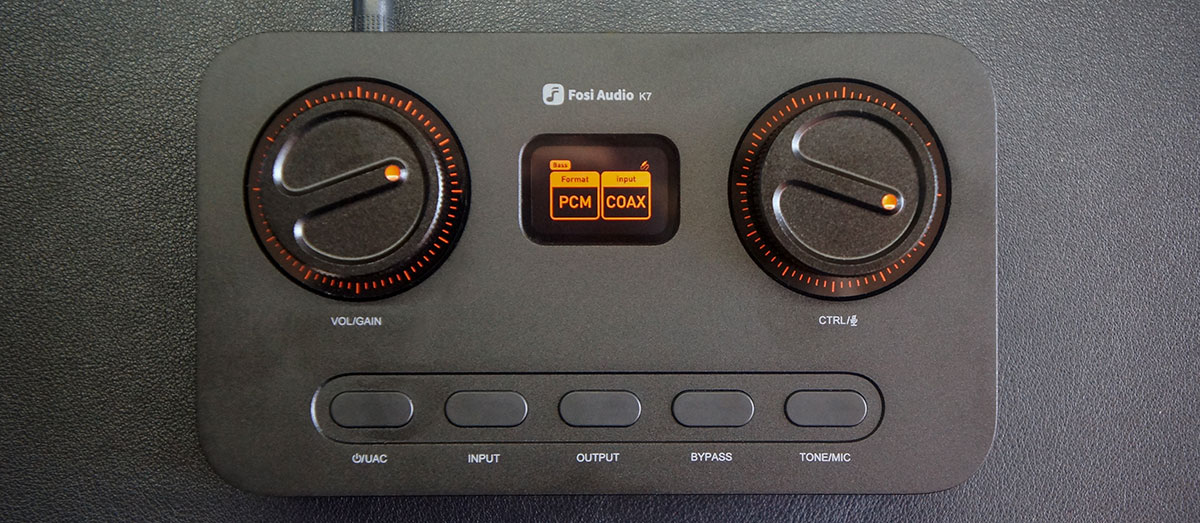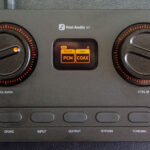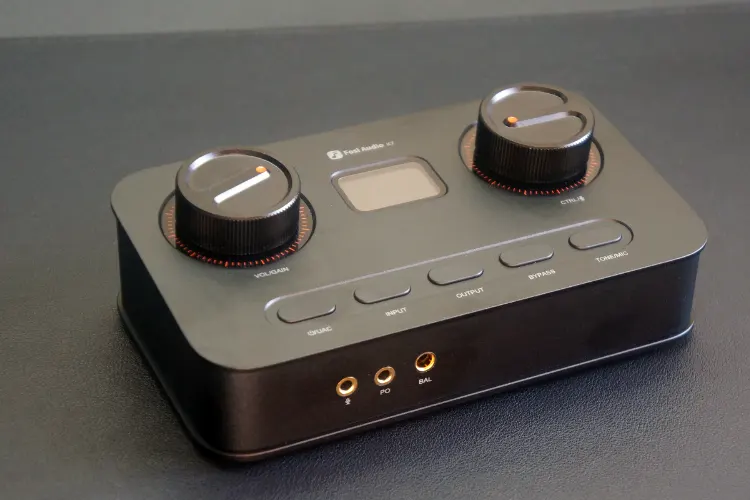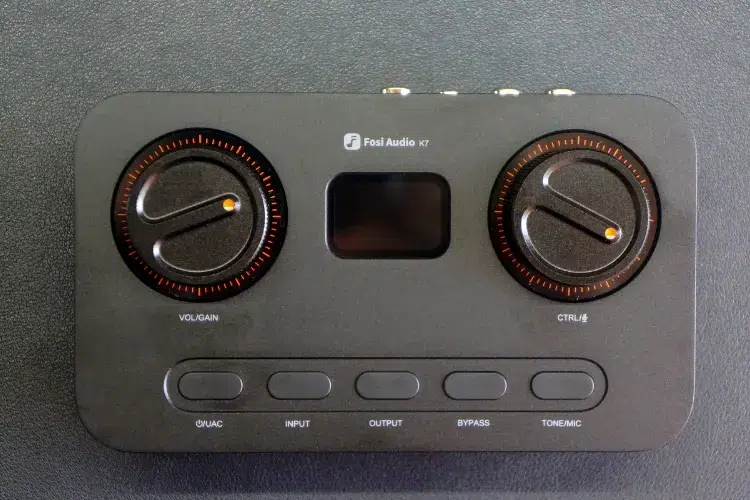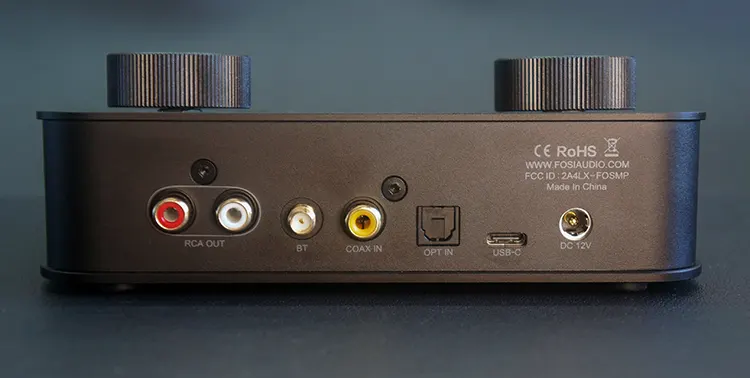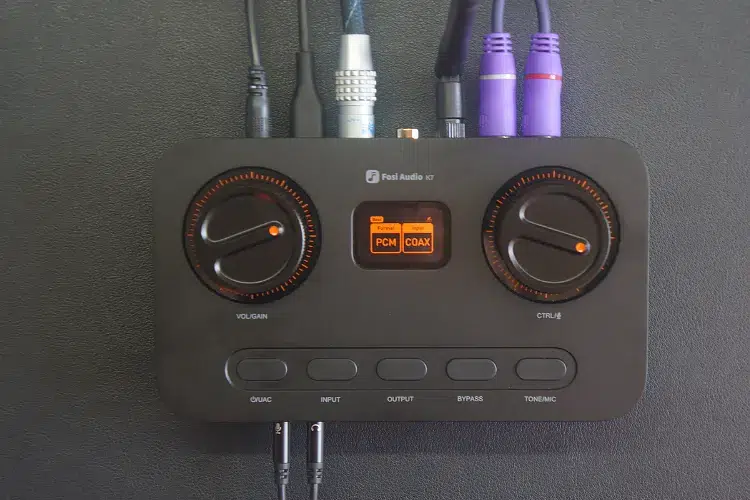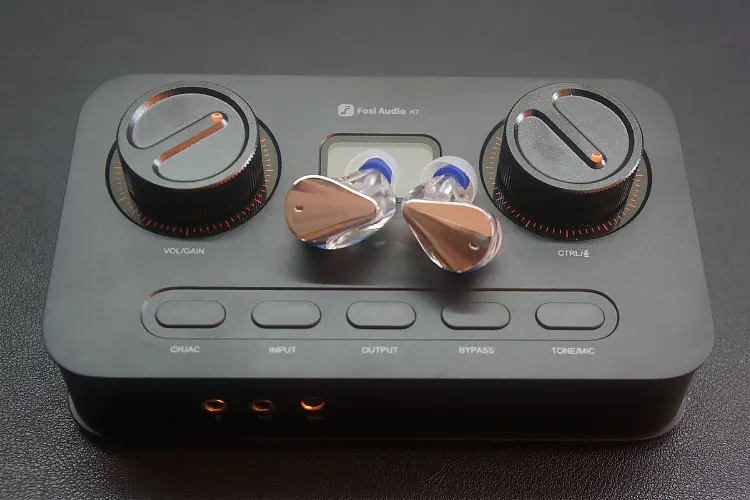In this feature, Meldrick reviews the Fosi Audio K7, a new Kickstarter-funded AK4493SEQ DAC and 2.1W balanced headphone amplifier for gaming. It is priced at $175.99, with Kickstarter options as low as $142.
Disclaimer: This sample was sent to me for my honest opinion. Headfonics is an independent website with no affiliate links. I thank Fosi Audio for their support.
You can click here to learn more about amplifiers previously reviewed on Headfonics.
This article follows our current scoring guidelines, which you can read here.
Audiophiles well-versed in the Chi-Fi speaker space may be familiar with Fosi Audio, a brand that has been steadily gaining attention for its affordable range of power amps, DACs, and combo units.
Today, Fosi is attempting to enter the hyper-competitive desktop DAC/AMP market with the K7, an all-in-one unit targeted towards audiophile gamers with specialty features such as a 3.5mm mic input and gain control.
Priced at $175.99, the versatility of the Fosi Audio K7 seems appealing, but to see how the newcomer compares against price-competitive DAC/amps in this market, such as the FiiO K11 and the Shanling EH1, read our full thoughts and impressions below.
Features
The Fosi Audio K7 aims to target audiophiles who game in between listening sessions by including a 3.5mm microphone input with an adjustable gain.
While audiophile-grade gaming headphones are quite rare, users who also pair their high-end headphones with detachable lavalier-type microphones may appreciate the extra functionality.
Another feature slowly gaining traction within the segment is the inclusion of bass and treble controls. The K7’s implementation is different from the dedicated treble and bass knobs of DAC/AMPs from Shanling, but like Shanling, it expands the unit’s potential synergy with a wide range of sound signatures.
The Fosi Audio K7 features the AKM AK4493SEQ DAC, capable of high-resolution decoding up to 32bit/384kHz PCM and DSD256.
This is paired with Texas Instruments TPA6120A2 amplifier chips to deliver up to 2.1W at 32Ω via its balanced 4.4mm output, providing ample power and control for a wide range of headphones and IEMs.
Design
Despite being targeted towards gamers, the K7 is devoid of any overtly loud RGB or sharp angular designs found in more typical gamer products.
Instead, the unit’s aesthetics are much more at home in typical desktop audiophile setups or professional audio environments.
Just like most Chi-Fi DAC/AMPs we’ve tested, the K7 comes in a CNC-machined aluminum body with an anodized black finish. However, it breaks the typical Chi-Fi monotony by including orange indicator markings on and around the two knobs placed on top of the unit.
This shade of orange complements the orange text on the monochrome 1.5 in display located in between the two control knobs.
Right below, there is an indented area for the 5 main control buttons to interface with the device’s menu system. The front and rear of the unit remain quite bare, housing the unit’s different inputs and outputs.
The K7 is free from any elements placed solely for decorative purposes. Since almost every element on the unit is used to control the unit or display information, the K7 has a utilitarian appeal with a slight visual flare coming from the black and orange color combinations.
I/O
The K7’s versatility shines with its suite of input and output options, making it a flexible and capable desktop DAC/AMP for various listening and gaming setups.
On the input side, it has USB-C, optical Toslink, and coaxial SPDIF, ensuring compatibility with a wide range of digital sources, from PCs, laptops, and gaming consoles.
To expand its compatibility with both the latest consoles, the K7 can be set to UAC 1.0 mode. This limits the K7’s maximum decoding capabilities, but it enables the unit’s microphone input.
Additionally, it features Bluetooth 5.0 with support for high-quality codecs such as aptX HD, allowing for wireless streaming without significant audio compromise.
For output, the K7 caters to both headphone and speaker users. The front panel houses a 3.5mm single-ended and 4.4mm balanced headphone output, providing users with flexibility based on their preferred headphone termination.
A dedicated 3.5mm microphone input is also included, enhancing its usability for gaming and voice communication.
The rear RCA outputs allow for seamless integration with powered speakers or external amplifiers, making the K7 a versatile hub for switching between desktop and hi-fi setups with a simple press on the dedicated output button.
Controls
The K7 has an intuitive control scheme that can be easily navigated through by using the 1.5-inch LCD screen and included control knobs and buttons.
Unlike other units, such as the FiiO K11, the K7 does not have a complicated multi-layer menu system. Instead, each function can be triggered or controlled by pressing a dedicated button on the device.
The two knobs placed on top of the unit has stepped tactile clicks and can spin infinitely. The tactile steps ensured that I could control the functions with precision and ease.
The two knobs can be pressed in as well. Pressing in the left knob enters the gain selection menu, while pushing in the right knob triggers the mic mute when in UAC 1.0 mode.
Pressing in the knobs requires more pressure than I’d hope. I can see some users who heavily rely on the mic muting function getting irritated at first, however I found myself getting used to the knob buttons after a few days.
The remaining buttons toward the bottom have a satisfying microswitch click that requires little force. This control scheme maintains the same versatility of other units while having a gentler learning curve than the competition.
Packaging & Accessories
The Fosi Audio K7 comes in a straightforward black box featuring an image of the device on the front. Inside, you get some essential accessories to allow users to get started right away.
Included in the box are a 12V power, a USB-C to USB-C cable with an attached USB-C to USB-A adapter, a Bluetooth antenna for wireless streaming, and a 3.5mm headphone and mic splitter for added versatility.
The included 3.5mm mic splitter means listeners with 4-pole gamine headsets can easily add the K7 to their existing gaming setups.
A USB-C to USB-A adapter on the USB-C cable also expands its out-of-the-box compatibility with different devices without having to juggle between different cables.
Sound Impressions
The following sound impressions were made with the Sennheiser HD 580, Audio-Technica R70X, Modhouse Argon, Moondrop Blessing 3, and Yanyin Canon II, my main headphone and IEM pairings.
Microphone impressions were completed with the Mirfak MC1 Lavalier Microphone. Unless otherwise stated, all listening impressions with the bass and treble controls set to 0.
Bass
The K7 has a clean, neutral sound signature with a slight punch in the sub-bass region. Acoustic kick drums and 808s reach deep and have a strong impact that doesn’t muddy the rest of the bass region.
In more modern Hip-Hop and Pop tracks, it provides a good, dynamic listening experience that can deliver good excitement without coloring too much of the track.
However, the mid-bass is a bit thin. Tracks that rely on velvety bass lines, such as funk and disco, sound like they lack a bit of note weight and warmth.
Adjusting the bass control adds a touch of warmth to the mid bass, but I found that this primarily increases the impact of the sub-bass region. By the time I reached my desired mid-bass level, the sub-bass was starting to muddy up the overall sound.
With a slight sub-bass emphasis and a clean bass presentation, the K7 can deliver deep-hitting sound without drowning out the mid-range.
Mids
The Fosi Audio K7 delivers an articulate and detailed midrange, particularly excelling with string instruments. Each guitar strum and plucked note is presented with natural harmonics, adding a sense of realism and clarity without overpowering other midrange elements.
Acoustic instruments and pianos come through with good energy, making it a great match for instrument-heavy genres like folk, jazz, and classical.
The controlled bass response plays a key role in maintaining this clarity, ensuring that low-end frequencies do not bleed into the midrange and preserving the integrity of stringed instruments and keys.
However, male vocals and instruments in the lower mid-range can sound like they’re missing a little more emphasis or body. While not lacking in detail, they do not carry the same level of weight and richness as the string and piano elements.
Treble
The Fosi Audio K7 delivers a lively and well-defined treble response, ensuring that hi-hats, cymbals, and chimes remain crisp and articulate. This treble clarity adds a sense of air and openness to tracks, enhancing their energy without sounding overly sharp or fatiguing.
In pop and electronic music, the treble’s sparkle makes the presentation more engaging. Percussive elements like snare hits and cymbal crashes are presented with forwardness and precision, contributing to the K7’s dynamic and energetic character.
At times, the treble can approach the edge of sibilance, particularly when paired with brighter, more neutral IEMs. However, throughout extended listening sessions, it maintains a balanced treble tuning that avoids harshness, ensuring long-term comfort even in treble-heavy tracks.
Staging & Dynamics
The Fosi Audio K7 offers a decent sense of staging, with well-defined instrument placement, particularly in acoustic recordings where string instruments are rendered with precision and a natural sense of space.
With its clean, uncolored tonality, it easily isolates individual instruments in complex mixes. However, its lack of warmth, especially in the mid-bass region, gives it a slightly narrow sounding sound stage.
This intimate presentation is not too severe; grand arrangements of multiple instruments still sound impactful, but it does not capture the same scale as warmer sources like the Shanling EH2.
Mic Input
The Fosi Audio K7’s microphone input is a welcome addition for audiophiles who need a convenient comms solution alongside their audio setup.
Paired with a Mirfak lavalier microphone, it delivers voice capture clear enough for business calls on MS Teams and gaming chat on Discord.
Background noise is kept to a minimum, and the inclusion of a dedicated mic mute button is a good quality-of-life feature that I used quite frequently.
Click on page 2 below for my recommended pairings and selected comparisons.

